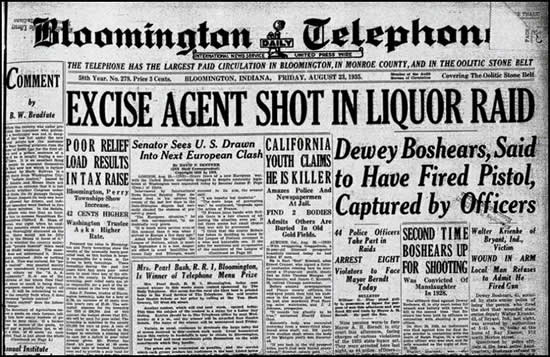Alcoholic Beverage Act of 1935
With the newly passed Alcoholic Beverage Act of 1935 in place, the Alcoholic Beverage Commission advised businesses that the deadline for the sale of alcoholic beverages without a new, Commission-issued permit would be midnight on Saturday, July 13, 1935. Governor McNutt advised reporters during a July 15, 1935 interview that the 269 liquor retailer permits, along with the 275 liquor dealer permits, was enough to, ". . . satisfy the normal demand for hard liquor in those communities where the sale of hard liquor by the drink is legal, and hence the lid is on and the law will be enforced."
The sale of "hard liquor" was only legal in 126 of the possible 520 cities and towns because many of the eligible towns with populations of less than 5,000 had not yet adopted the required enabling ordinances. Throughout the state the local alcoholic beverage boards were busy conducting hearings on the new applications.
In August, officers began a string of raids in Bloomington. These raids culminated with a large, multi-agency operation on the night of Friday, August 23, 1935. According to the Bloomington Telephone newspaper, a contingent of ". . . forty-four police officers – including G-men, excise police, state detectives, city police, sheriff’s officers, constables, and special police – swarmed down on 18 alleged liquor joints at the same time. State excise police chief Ray Hinkle was in charge of the raids, coming here from Indianapolis. The raids were scheduled to take place at the same time, and were made so rapidly that little word of it spread to illicit liquor dealers until after the raids were completed. The state men came into Bloomington yesterday afternoon, bringing the four G-men with them. Squads of three and four officers made the raids, each squad making about two raids. . ."

Officer Walter Krienke was shot by Dewey Boshears during as he attempted to serve a warrant at the suspect’s residence on August 23, 1935. Seven years earlier Boshears had shot and killed Bloomington Police Officer Ralph Pogue. Krienke recovered from the wound and served with the department until 1954.
Officers spent the rest of the summer of 1935 focused on closing down the roadhouses still operating without commission-issued permits. In the first year and a half of its existence, the department confiscated 474 illegal stills; made 3,231 arrests; and seized 63 cars and 8 guns. Offenders arrested by officers had been sentenced to a total of nineteen years in prison.
